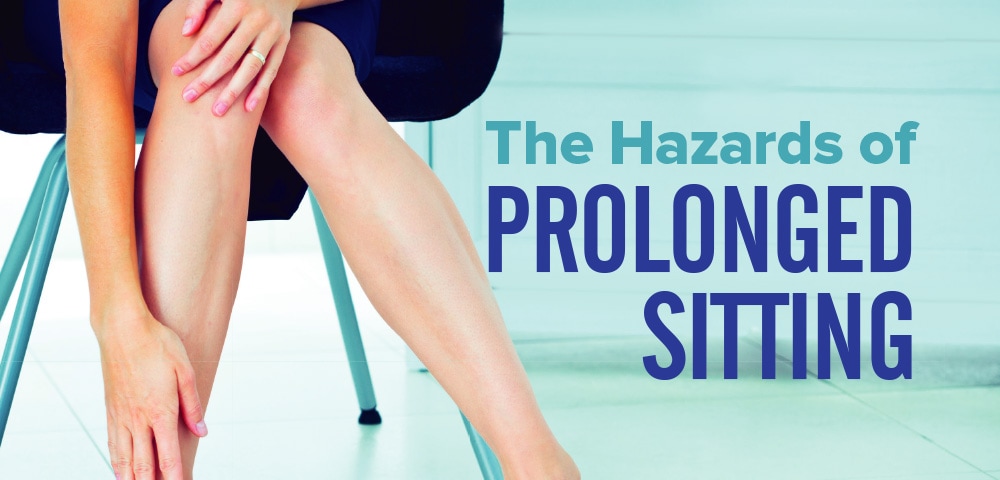
We are sitting more than ever. The pandemic has brought about many changes, including a push towards a more sedentary lifestyle.
Limitations of everyday movement and physical activity stemmed from staying home, but were also a result of disappearing daily commutes, increased screen time, and extended gym restrictions. Even before the pandemic, research showed an average sedentary time of 8.83 hours per day among adults aged 20–75 years. We cannot deny that sitting and being inactive for extended hours can be detrimental to our health. Such behaviour is associated with many negative health outcomes such as cardiovascular disease, type 2 diabetes, obesity, deep vein thrombosis (DVT), and mental health concerns in both children and adults.
Research showed an average sedentary time of 8.83 hours per day among adults aged 20–75 years.
Consequences of Prolonged Sitting
Humans were not made to be inactive for prolonged periods of time, especially in sitting, lying, or reclined positions. Our evolution has been influenced by high levels of physical activity, such as long-distance walking and running, due to hunting and gathering lifestyles. In the past, periods of inactivity still involved some muscle activity as people spent their rest time in postures like squatting or kneeling. Today, we frequently spend work and relaxation time sitting or lying, and the negative consequences of this are plenty.
Prolonged sitting along with reduced muscle activity can lead to obvious tightening of muscles, stiff joints, and increased body pain. Headaches, poor posture, difficulty with balance, and back pain are common complaints. Research has also shown that extended sitting can increase the risk of cardiovascular disease, diabetes, and metabolic syndrome due to insulin resistance in skeletal muscle, along with increased blood pressure, triglycerides, cholesterol, postprandial (after mealtime) glucose, and insulin levels.
Sitting for too long can lead to reduced blood flow, impairing endothelial function of the vessels and increasing the risk for peripheral artery disease (PAD) in the legs. PAD is a consequence of atherosclerosis in the arteries (a build-up of plaque in the artery walls), which in turn, can narrow these vessels and further reduce blood flow in the legs. Unfortunately, this stagnant blood flow can cause the blood to thicken, leading to increased risk of clots. Clots can also form in the deep veins of the legs, a condition known as DVT. Unfortunately, these clots can break off from the vein, travel through the bloodstream to the lungs, causing a pulmonary embolism, a potentially fatal condition.
Stay Safe, but Not Sedentary
Although we may still be distancing to remain safe and protect others, it does not mean we need to be sedentary. Make a choice to engage in frequent movement.
Schedule movement breaks
Although you might do a workout regularly, it’s still essential to break up prolonged periods of sitting with regular movement and stretching breaks. Increasing physical movements will lead to improved circulation, increased muscle activity, and reduced postprandial glucose and insulin levels. Set reminders during your day to walk up and down stairs, skip around your desk, or head outside for some fresh air.
Promote health with the Mediterranean diet
One of my favorite dietary approaches to support the negative impact of a sedentary lifestyle is the Mediterranean diet. Full of fruits, vegetables, nuts, seeds, beans, fish, whole grains, and healthy fats, this dietary approach is well known to lead to positive health outcomes. Providing an array of nutrients, such as antioxidants, fiber, and polyunsaturated fatty acids, the Mediterranean diet has been shown to lower lipids, blood sugar, insulin, and blood pressure, while also helping to reduce body weight, protect against oxidative stress and inflammation, and support the gut microbiota.
Support vessel health with nutrients
Nutrients can play a key role in supporting blood vessel health and blood flow. One such example is collagen, an abundant protein in the body that plays a role in supporting the structure of blood vessels and other important tissues. Insufficient levels of collagen, which unfortunately decline as we age, can lead to fragile blood vessels. Supplementing with collagen and other supportive nutrients such as vitamin C and lysine, can provide additional support to strengthen blood vessels and promote better blood flow. Omega-3 fatty acids have been shown to have anti-inflammatory effects and increase levels of nitric oxide, a compound that helps dilate blood vessels to help improve circulation.
Omega-3 fatty acids are readily available in fish, such as salmon, anchovies, and sardines; and fish oil supplements; and plant sources, such as chia, hemp, and flax seeds. Beets also help increase nitric oxide levels and improve blood flow. In a double-blind, placebo-controlled clinical trial daily dietary supplementation for 4 weeks with dietary nitrate in the form of beetroot juice led to a reduction in blood pressure and arterial stiffness, and improved endothelial function. Be sure to add beets to salads and soups, and look for beets in a powder form that can be added to smoothies and smoothie bowls.
Increase circulation with dry skin brushing
Prolonged sitting not only leads to reduced blood flow, but also sluggish lymphatic flow. The lymphatic system helps the body get rid of waste and other toxins, but relies on the body’s movement to function properly. Dry skin brushing is an important technique used to increase blood circulation and promote lymph flow. Dry skin brushing is ideally done twice per week before a shower.
Staying safe and healthy continues to be the priority during these unprecedented times, but that does not mean we need to remain sedentary to achieve this goal. We can continue to support our global goals, while we continue to prioritize our current and future health.
References
Loyen A, Clarke-Cornwell AM, et al. Sedentary time and physical activity surveillance through accelerometer pooling in four European countries. Sports Med. 2017; 47(7):1421-35.
Compernolle S, DeSmet A, Poppe L, et al. Effectiveness of interventions using self-monitoring to reduce sedentary behavior in adults: a systematic review and meta-analysis. Int J Behav Nutr Phys Act. 2019; 16(1):63.
Bates LC, Zieff G, Stanford K, et al. COVID-19 impact on behaviors across the 24-hour day in children and adolescents: physical activity, sedentary behavior, and sleep. Children (Basel). 2020; 7(9):138.
Physical activity and screen time among Canadian children and youth, 2016 and 2017. Statistics Canada. Accessed: https://www150.statcan.gc.ca/n1/pub/82-625-x/2019001/article/00003-eng.htm
Raichlen DA, Pontzer H, Zderic TW, et al. Sitting, squatting, and the evolutionary biology of human inactivity. Proc Natl Acad Sci U S A. 2020; 117(13):7115-21.
Saunders TJ, Atkinson HF, Burr J, et al. The acute metabolic and vascular impact of interrupting prolonged sitting: A systematic review and meta-analysis. Sports Med. 2018; 48(10):2347-66.
Padilla J, Fadel PJ. Prolonged sitting leg vasculopathy: contributing factors and clinical implications. Am J Physiol Heart Circ Physiol. 2017; 313(4):H722-8.
Quan M, Xun P, Wu H, et al. Effects of interrupting prolonged sitting on postprandial glycemia and insulin responses: A network meta-analysis. J Sport Health Sci. 2020; S2095-46(20)30170-8.
Loh R, Stamatakis E, Folkerts D, et al. Effects of interrupting prolonged sitting with physical activity breaks on blood glucose, insulin and triacylglycerol measures: A systematic review and meta-analysis. Sports Med. 2020; 50(2):295-330.
Tuttolomondo A, Simonetta I, Daidone M, et al. Metabolic and vascular effect of the Mediterranean Diet. Int J Mol Sci. 2019; 20(19):4716.
Felau SM, Sales LP, Solis MY, et al. Omega-3 fatty acid supplementation improves endothelial function in primary antiphospholipid syndrome: A small-scale randomized double-blind placebo-controlled trial. Front Immunol. 2018; 9:336.
Kapil V, Khambata RS, Robertson A, et al. Dietary nitrate provides sustained blood pressure lowering in hypertensive patients: a randomized, phase 2, double-blind, placebo-controlled study. Hypertension. 2015; 65(2):320-7.












